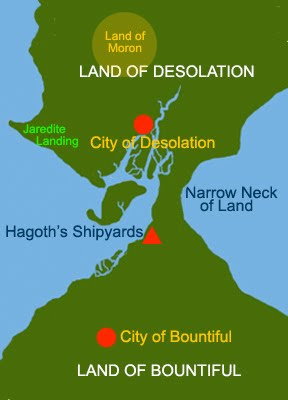 “The two crucial land masses were called the land southward and the land northward. They were connected by an isthmus described as "narrow." The Nephites thought of their land as "nearly surrounded by water" and, at least in their early days, as an "isle of the sea" (Alma 22:32; 2 Nephi 10:20). (Isle anciently did not necessarily mean an area entirely isolated by water, but rather that the area so labeled could be reached via boat. See the dictionary in the Latter-day Saint edition of the King James Version of the Bible, s.v. "Isles.")”
“The two crucial land masses were called the land southward and the land northward. They were connected by an isthmus described as "narrow." The Nephites thought of their land as "nearly surrounded by water" and, at least in their early days, as an "isle of the sea" (Alma 22:32; 2 Nephi 10:20). (Isle anciently did not necessarily mean an area entirely isolated by water, but rather that the area so labeled could be reached via boat. See the dictionary in the Latter-day Saint edition of the King James Version of the Bible, s.v. "Isles.")”First of all, the KJV Bible Dictionary has little value for it is based upon factors not consistent with the time frame, manner of interpretation, and the method of translating employed in Joseph Smith’s day. The only dictionary worth using for this purpose is the one Noah Webster published in 1828, which has been discussed in numerous earlier posts, that covered the language of New England that Joseph knew at the time he translated the record.
Secondly, the word used above by Mesoamerican theorists is “isthmus,” a word never used in the scriptural record and actually means “a land of considerable extent between seas,” which matches the Isthmus of Tehuantepec, but does not match Mormon’s description of a “small neck of land” (Alma 22:32). Now the term “neck” as used with land, is defined as a “narrow tract of land projecting from the main body, or a narrow tract of land connecting two larger tracts,” which is exactly how Mormon meant the term, which he also called a “narrow neck” (Alma 63:5), and exactly how Joseph Smith translated it. Thus, it cannot be said that the Land Southward and the Land Northward “was connected by an isthmus,” but rather, it was connected by a “small” or “narrow neck of land.”
Third, we do not know how the Nephites thought of their land. We do know that Mormon described the Land Southward as surrounded by water except for this narrow neck (Alma 22:32). It would stand to reason that the Nephites thought of it that way, but Mormon lived long after that “small” or “narrow neck of land” was never again mentioned in the scriptural record, suggesting it had been changed in some way at the time of the crucifixion described in 3 Nephi.
 Fourth, it is not a matter of the Nephites THINKING they were on an “isle of the sea.” They were obviously ON such an isle, as Jacob said: “for the Lord has made the sea our path, and we are upon an isle of the sea” (2 Nephi 10:20).
Fourth, it is not a matter of the Nephites THINKING they were on an “isle of the sea.” They were obviously ON such an isle, as Jacob said: “for the Lord has made the sea our path, and we are upon an isle of the sea” (2 Nephi 10:20). Fifth. Now the important and very inaccurate statement made is that the word: “Isle anciently did not necessarily mean an area entirely isolated by water, but rather that the area so labeled could be reached via boat. See the dictionary in the Latter-day Saint edition of the King James Version of the Bible, s.v. "Isles.” Again, what the term meant anciently to the Nephites is completely unknown. As Moroni said after 1,000 years: “We have written this record according to our knowledge, in the characters which are called among us the reformed Egyptian, being handed down and altered by us, according to our manner of speech” (Mormon 8:32). And their original manner of speech was also different: “the Hebrew hath been altered by us also” (Mormon 8:33).
What is important to understand is what did the term Joseph Smith used mean to him? The Noah Webster 1828 dictionary says of the word isle: “a tract of land surrounded by water; a detached portion of land embosomed in the ocean.” And this is exactly how Jacob described it.
The question might be asked, “Why did Joseph use the word ‘isle’ rather than ‘island’?” Again, the dictionary makes it quite clear. In 1828, in New England, where Joseph grew up, the word “island” is described as: “An absurd compound of isle and land,” which would mean “land-in-water land” or “eiland land.” Webster goes on to write in his dictionary: “There is no such legitimate word in English…the genuine word always used in discourse is our native word ‘isle’,” from the Saxon “ealond.”
Perhaps to be a little silly, the statement “but rather that the area so labeled could be reached via boat” must mean that, because one can reach the United States by boat from Canada (across one of the Great Lakes), that the United States is an island. Or that you can reach Mexico by boat from Baja, thus Mexico can be described as an island. Or that Arkansas can be reached by boat from Tennessee (across the Mississippi—the only way to reach either shore before bridges were built) makes one or both of these states an island.
Obviously, what is meant by both Jacob and Joseph Smith, is that the word “isle” does mean a piece of land surrounded by water as stated.
(See the next post, “Where the Events of the Book of Mormon Took Place – Part III,” for more of these inaccurate points)




No comments:
Post a Comment